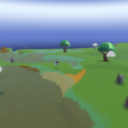Home/Resources/Water Cycle Model
Water Cycle Model



- Lesson 3: Remix: Water connects us all
- Student Ages: 10-14 years old
- Activity Time: 1 day (60 minutes)
- Activity Level: Beginner Coder
Description: Lesson 3 presents students with the challenge to construct their own model showing the relationship that exists between bodies of water, currents, temperature and weather patterns using tools, objects and techniques available in the Kodu community site.
Prerequisites
- Download and Installation of Kodu
- Lesson 1: Play Water All Around Us
- Lesson 2: Remix Water Connects Us All
Learning Objectives
- Observe, experiment with a computer model, and create hypotheses, of the relationships between water bodies, underwater populations, and human activity.
- Research, Design, and Construct a model of the water cycle using Kodu Game Lab.
- Demonstrate an understanding of the water cycle and the major factors contributing to it by presenting the model to their instructor and peers.
- Demonstrate an understanding of the role that human activity can have on the environment through the water cycle, by modeling phenomena such as acid rain in their Kodu level.
Contents
- Lesson 3: Create Water Cycle Model
- Level 3: Starter World Kodu and the Water Cycle
- Level 3: Starter World Waterfalls using creatables
Student Activities
Activator(
Students will discuss prior knowledge on the water cycle. Students will consider if the earth has more or less water now than 1,000 years ago. Students will consider where the water that is on the ground comes from. Students will consider how water get into the oceans. Students will provide their understanding of clouds, rain, and snow.
Subjects:Science, Computer Science, Engineering, 21st Century Learning
Project-Based Learning: Creating a Water Cycle Model Game in Kodu(
Students will work in of 2-3 people and use Kodu Game Lab to create a game that models the water cycle. Students will create a checklist and format that students should complete in order to ensure that all the requirements requested by their instructor are met. Students will respond the leading discussion questions in their teams. Students will begin their project using the baseline level (Kodu world) provided. This level includes a topography consisting of multiple altitudes from the bottom of the ocean to a high mountain peak. It features sandy coastlines and rivers that run through the landscape. This variety is designed to inspire ideas, and to encourage them to modify it as necessary to produce their model. Students will examine water currents, pollution and food safety. Students will be encouraged to explore some of the ways in which different phenomena involved in the cycle can be represented in Kodu.
Subjects:Science, Computer Science, Engineering, 21st Century Learning
Performance Expectations
Lesson Project: Student Presentations(
Students should present their model to the whole group. The presentation should include an explanation of the aspects of the water cycle they have represented and how they are simulated n the students’ creation..
Skills
Character, Citizenship, Collaboration, Communication, Creativity, Critical Thinking, Project Based Learning
